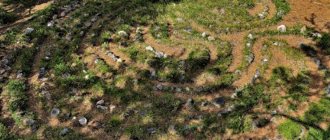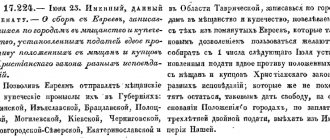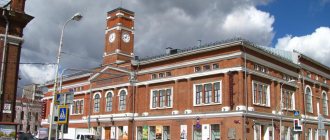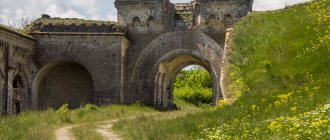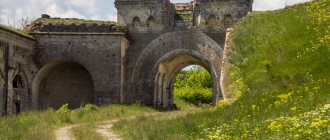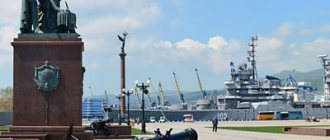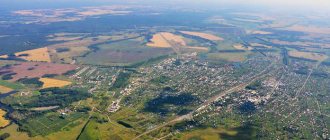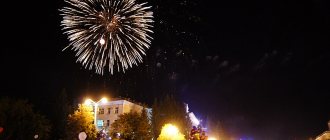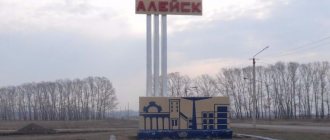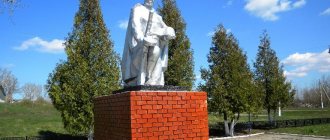Video of the First Channel’s special project “Cities of Victory”
Kerch was one of the first cities to come under attack by Nazi troops at the beginning of the war. During the entire war, the front line passed through the city four times and it was twice occupied by enemy troops.
During the occupation, 15 thousand civilians died, and more than 14 thousand Kerch residents were taken to Germany for forced labor. The city was captured for the first time in November 1941 after bloody battles. But already on December 30, during the Kerch-Feodosia landing operation, Kerch was liberated by troops of the 51st Army.
Great Patriotic War of 1941-1945. Kerch region. Armored boats with landing forces in the Kerch Strait. 1944
S. Kulishov / RIA Novosti
In May 1942, the Nazis concentrated large forces on the Kerch Peninsula and launched a new attack on the city. As a result of heavy and stubborn battles, Kerch was again abandoned to the enemy. The stubborn struggle and long defense in the Adzhimushkay quarries became a legendary page in the history of the Great Patriotic War. The underground and partisans waged an active fight against the invaders.
During the 320 days that the city was in the hands of the enemy, the occupiers destroyed all the plants and factories, burned all the bridges and ships, cut down and burned parks and gardens, destroyed the power station and telegraph, and damaged the railway lines on the peninsula. Kerch was almost completely wiped off the face of the earth.
The beginning of the war - the attack on the Kerch Peninsula
The Second World War came to Kerch in the summer of 1941. Two brigades are being formed in the city - the people's militia and the destroyer battalion. In the first months of the war, more than 1,500 volunteers and more than 15 thousand conscripts went to the front. Thousands of Kerchan residents of non-conscription age – young boys and girls – are joining the people’s militia.
The evacuation of civilians began in August, and of industrial enterprises in September. Despite the shortage of equipment and personnel, the Kerch Metallurgical Plant continues to produce flamethrowers, grenades, mortars, and anti-tank incendiary mixture for the front. In the first months of the war, the plant produced two armored trains.
Kerch Metallurgical Plant 1942 Source: waralbum.ru
Advanced German units enter Crimea on September 12 and begin an offensive in the direction of the Kerch Peninsula. Kerch is one of the main strongholds of the peninsula. From here the path to the Taman Peninsula and the Caucasus was open for the Nazis.
Focke-Wulf FW-190 aircraft
Since October, the city begins to be bombed daily by Lutwaffe planes. Since October 27, real hell has been happening in Kerch. More than 600 air bombs are dropped on the city, the railway junction and port are completely destroyed. Kerch burned for several weeks.
On November 4, the Kerch defensive region was created, which includes the Kerch naval base and units of the 51st Army. But this no longer helps stop the enemy. By this time, Soviet units were holding out on the Kerch Peninsula with all their strength.
The KVMB observation post was located on the Mithridates Stairs. Source: waralbum.ru
There was only one way out - to save the army’s equipment and weapons. Otherwise, the Germans will inevitably defeat the remnants of the troops and move on - to Taman and to the Caucasian oil.
The command decides to evacuate troops on November 14. Retreating, Soviet troops blow up fuel depots, a floating dock, the Voikov plant, a water supply system, and power plants.
Several dozen civilian ships and fishing seiners are transporting about 50 thousand soldiers and over 400 guns from Kerch to Taman. The evacuation takes place under constant fire from enemy artillery and mortars.
Entertainment in Kerch
Those who love entertainment more than viewing historical antiquities will also not be bored in Kerch. Entertainment establishments operate both in the center and in the suburbs. Tourists coming to the city should visit:
- children's Disneyland;
- amusement park;
- a unique poultry farm where ostriches are raised.
A tour of the poultry farm must be booked in advance. Here you can take interesting photos and watch birds.
Disney Park
Disney Park is a popular family holiday destination, modeled after European Disneylands. Here you can visit an amusement park, celebrate a birthday, take pictures with life-size puppets depicting children’s favorite characters from popular cartoons and fairy tales. If the weather is bad, you can go to game centers.
Entertainment programs and master classes for children and teenagers are regularly held on site. There are quiet relaxation areas for parents with children under three years old, and several small cafes where you can have an inexpensive and tasty snack.
Children's amusement park
The children's amusement park is located right on the Kerch embankment, so you can combine entertainment with a beach holiday. One of the main attractions of the park is a huge Ferris wheel, which is clearly visible from different points of the city. After a ride on the wheel, you can admire the views of Kerch from a bird's eye view and take interesting photos. The park is divided into several zones: for children with parents under 3 years old, for preschool children, for schoolchildren and teenagers.
Ostrich farm
This place will certainly appeal to children and adults. The ostrich farm is the only farm in Russia where you can see real live ostriches. Exotic birds thrive in the local climate and lay eggs regularly. Here you can watch the life of birds and their feeding.
The farm is located near the ferry, which acts as a ferry from Kerch to the Caucasus, in the village of Podmayachny. Ostriches arrived here in the early 2000s, amid increased interest in exotic animals and agriculture. There are organized tours of the farm, a café, and ostrich-related souvenirs such as miniature ostrich eggs. The guide will tell you about the life of ostriches, what they eat, and what benefits they bring to humans.
First occupation: mass destruction of civilians
The Germans begin to rule the city on November 16th. The occupation of the city lasted only six weeks. But they were remembered by the civilian population as one of the most terrible periods of the war.
A column of German soldiers on the street of Kerch during the parade. November 27, 1941. Source: waralbum.ru
At this time, mass executions of the population took place. First of all, the SS task force begins registering and exterminating Jews, Gypsies, communists, Crimeans, and Komsomol members.
The Nazis began their monstrous atrocities with the poisoning of 245 schoolchildren. Then followed the tragedy of the Bagerovsky ditch - the Nazis tortured and killed over 7 thousand civilians.
Kerch. Gymnasium No. 2 (formerly women's gymnasium). The place where the Nazis poisoned 245 innocent children.
The building of the oldest gymnasium in Kerch after restoration.
This massacre site was discovered in January 1942 by Soviet troops. The ditch, 4 meters wide and 1 kilometer long, was overflowing with the corpses of women, children, and old people.
Kerch. Bagerovsky ditch. Photo "Grief". Source: waralbum.ru
How many civilians died during these month and a half in Kerch is still not known for certain. The Nazi atrocities in Kerch became one of the terrible episodes of the Nuremberg trials.
Residents of the city from the very first days of the occupation began to fight against the enemy. Back in early November, during the period of evacuation of Soviet troops, two partisan detachments were formed in the city - Starokarantinsky and Adzhimushkaysky. Quarries become hiding places for partisans. The struggle against the invaders underground continues until the liberation of the city by Soviet troops at the end of December 41st.
Kerch. Adzhimushkay quarries. Memorial ensemble at the entrance to the quarries
Kerch. One of the entrances to the Starokarantinsky quarries
Monument to border guards in Adzhi-Mushkai
And again the “tragic” Adzhi-Mushkay. Not far from the memorial group and the underground museum “Adzhimushkai Quarries” we will meet an ensemble consisting of a boundary pillar and a memorial slab with an inscription (all this is placed on a granite pedestal, where a staircase leads). The object is visible in the wasteland. You won't get lost.
The complex is dedicated to the front-line soldiers of the 95th Border Regiment, who fell in two military operations at once near a populated area. The object was reconstructed in 2010 (before that there was only a pillar). There are still a lot of monuments dedicated to the Second World War in the city of Kerch, for example, to Soldiers-Aviators, Paratroopers, a composition in Voykov Park, etc.
On topic: Museums of Kerch
Pay attention to the photo. The WWII monuments in Kerch are dedicated to both the soldiers of that terrible war and its victims among the local population. Some compositions are positioned so that they are clearly visible from the sea, and from afar. Reviews call the city we described as “the place of Glory of several wars at once.” Appreciate each work of monumental sculptors. As a rule, their works are shown by guides. In conclusion, we offer an educational video, enjoy watching.
Liked? Share with your friends!
First liberation of the city: Kerch-Feodosia landing
The website has a full article on the Kerch-Feodosia landing operation
The Soviet command could not come to terms with the loss of the Kerch Peninsula. In a short time, a liberation plan was prepared: amphibious landings in Feodosia and Alushta and a forced march to the Ak-Manai Isthmus. The operation began a week before the New Year.
The landing was complicated by bad weather in the Sea of Azov and the Kerch Strait. By the evening of December 26, the storm intensified to almost 7 points - the torpedo boats were flooded and thrown from side to side.
Severe frost (-15 degrees) formed an edge of ice near the shore, which prevented the boats from approaching. Under enemy artillery fire, the paratroopers had to jump straight onto the sandbank and go on the attack in chest-deep icy water. They carried light guns, equipment and ammunition ashore on their hands
The landing force lands in the area of Kamysh-Burun, Stary Karantin and Eltigen. But they manage to gain a foothold only on the Kamysh-Burun Spit, on the former pier of the ship repair plant.
For two days the paratroopers held back the enemy onslaught. They suffered huge losses and were already preparing for the last battle. But on December 28-29, 11 thousand soldiers, mortars, machine guns, and cannons were transferred to help them.
On the night of December 30, scouts who penetrated Kerch discovered that the Germans had abandoned the city and retreated to the west. The first occupation of Kerch is completed. At the same time, Soviet troops landed in the Feodosia area.
The transfer of Soviet troops to the Kerch Peninsula continued until January 3, 1942. At this time, to the surprise of the old-timers, the strait froze, and a route was immediately laid on the ice. 300 guns, 6 thousand vehicles, 6 rifle and 1 cavalry divisions were transferred along the ice road to Kerch.
Red Navy soldiers are conducting surveillance on the roof of a house in liberated Kerch (the first liberation of the city). Source: waralbum.ru
Liberated Kerch becomes a military base for Soviet troops in Crimea. The enemy understands this too. Enemy air raids do not stop in the city; Soviet anti-aircraft guns are constantly fighting from the ground.
In these conditions, active activities are carried out at the enterprises of Kerch. Workers at the Voikov plant repair guns, tanks, cars, manufacture ammunition, and build a new armored train for the front. Vessels with military cargo for units of the Soviet Army depart from the berths of the Kerch port.
Kerchan residents want to believe that they have finally returned to peaceful life. The city's water pumping station is being restored, the newspaper is starting to be published again, and several city schools and bread stores are opening. But soon the Great Patriotic War returns to Kerch again.
Sights of Kerch, within walking distance from the city
Mud volcano Jau Tepe
A natural attraction of Kerch are mud volcanoes, which are located 11 kilometers from the city. It is better to get there by SUV or four-wheel drive. Such volcanoes erupt, and the height of the mud column is 8-10 meters. There are legends that transport disappeared in mud volcanoes during the Second World War. The appearance of volcanoes is varied. Some resemble a real crater, others resemble a flat and deep lake. The most famous mud volcano is Jau Tepe. Now it is in an inactive phase. There is no entrance fee and there are no guided tours. Read more about Jau-Tepe.
Ostrich farm Exotic
Near Kerch there is an ostrich farm, which is home to about 50 ostriches. One female brings from 35 to 80 eggs per season, the weight of which ranges from 1.3 kg to 1.5 kg. Ostriches need a lot of space to live, so enclosures are built with a length of 40 meters. The farm is located near the village of Glazovka and is open from 9:00 to 23:00. Ticket price is 200 rubles. Read more about the Exotic Ostrich Farm.
Adzhimushkay quarries
The quarries of Kerch are steeped in history: tragic and heroic events. Here, for 170 days, almost 120 thousand people resisted the German occupiers. Subsequently, a monument was built here in memory of the victims. The quarries were peaceful. Limestone-shell rock was mined here. Many houses and structures were built from this building material on the Crimean Peninsula. These quarries were opened in the 1850s. During this time, the builders dug catacombs 20 kilometers long. Surprisingly, only half of the entire length of the catacombs has been studied to this day. It is very dark in the quarries, the humidity is 100%, the air temperature is constant - 8˚C. Today you can see authentic soldiers' helmets and various military attributes of the war period there. Today, an underground museum is open in the quarries from 9:00 to 18:00. Ticket price is 200 rubles. The tour lasts about 1 hour. Read more about Adzhimushkay quarries.
Tsarsky Kurgan
Not far from the quarry, there is the Kerch Historical and Cultural Reserve “Tsarsky Kurgan”, the burial place of military leaders. The archaeologists who found this tomb were hoping to find a lot of jewelry and historical objects. However, this did not happen; the mound was plundered. Their only reassurance was the fantastic architecture of this tomb. Today, the Tsarsky Kurgan operates as a museum and is open to visitors from 9:00 to 18:00. Ticket price is 200 rubles. With excursion - 500 rub. The tour lasts approximately 25 minutes. Read more about the Tsarskoe Kurgan.
Cape Zyuk
Cape Zyuk is the northernmost point of the Kerch Peninsula and is famous for its beautiful beaches. In addition to nature, on the cape, there are excavations of an ancient settlement. Tourists to Cape Zyuk are attracted by the opportunity to swim in the Azov Sea, which is always several degrees warmer, and by beautiful sandy beaches that are suitable for families with children. Read more about Cape Zyuk.
Second attack on Kerch: “Hunting for Bustards” and “Soviet Dunkirk”
The site has a full article “Hunting Bustards”
On January 28, a new Crimean front is created - the smallest in length and one of the shortest in the history of the Great Patriotic War.
Headquarters orders to launch an offensive and completely liberate Crimea. But the troops of the Crimean Front, trying to advance three times (from February 27 to April 13), were never able to push back the Wehrmacht troops. In January 1942, the Germans reoccupied Feodosia.
The High Command gives the order to stop the offensive and create a strong defense in Kerch. At the end of May, the Crimean Front was supposed to go on the offensive again, but Hitler’s troops were ahead of the General Headquarters’ plan.
Kerch defensive operation or “Hunting for Bustards”
Operation "Hunting for Bustards".
Documentary footage from the German historical archive On March 28, 1942, Hitler announces a new summer campaign. The plan to seize the Kerch Peninsula receives the code name “Hunting for the Bustard.”
For the first time, powerful Wehrmacht equipment - tanks and heavy artillery - is being sent to Crimea. And German submarines and torpedo boats begin to operate in the Black Sea.
By this time, the Crimean Front had about 250 thousand soldiers, and had a fairly impressive arsenal of military equipment. But the Soviet command did not prepare for defense, contrary to the decree of Headquarters.
Soviet troops do not have strong defensive lines and are gathered “in a heap.” All three armies stand behind each other's heads in open areas - a huge number of troops and equipment are concentrated in one place.
On the night of May 7–8, the Germans launched a massive artillery and tank attack on a concentration of Soviet troops. The soldiers of the Red Army fight selflessly, but the forces are unequal, and the position of our troops is not advantageous. Most of the command posts were immediately destroyed by the Germans, and communications among the troops were disorganized.
In just three days, the Nazis break through the Crimean Front in the center of the Turkish Wall, where the highway to Kerch passes.
By the evening of May 13, the enemy begins to actively bomb the city - more than 2 thousand bombs fall on Kerch on that day alone. On May 14, German troops reached the shore of the Kerch Strait in several places and captured Mount Mithridates.
Officially, the second occupation of Kerch begins on May 15, 1942. But in fact, the city did not give up its position for several more days. There were fierce battles on the streets of the city, every house was turned into a fortress.
Until May 18, fighting takes place on the territory of the Voikov plant. Here, groups of Red Army soldiers and factory workers isolated from the troops resisted until the last fighter. An armored train built at the plant also takes part in the battles.
On May 20, the last heroic defenders of Kerch died - about 2 thousand soldiers who fought on the territory of Yeni-Kale.
Sights of Kerch in the south of the Kerch Peninsula
Nymphaeum fortification
After settling Panticapaeum, the ancient Greeks began to populate the nearby shores of the Kerch Peninsula. So, at the turn of the 6th-5th centuries BC, the small settlement of Nymphaeum appeared. It is located near the village of Chelyadinovo. Today the settlement is an open-air museum. There is no entrance fee, although the site is under state protection. Read more about the Nymphaea settlement.
Eltigen Landing Museum
Between the villages of Priozernoye and Chelyadinovo, on the Black Sea coast, there is a memorial complex dedicated to the attempt in 1943 to liberate the Kerch Peninsula. At the site of the Memorial complex there was a landing of about 6 thousand people. After an unsuccessful assault, they retreated to Kerch and held the city for almost a month. About 2 thousand people survived the operation. Today, there is an open-air museum at the Landing site. The museum is open from 9:00 to 18:00, and there are guided tours on site. Read more about the Eltigen Landing Museum.
Acre Crimea
Behind Chelyadinovo there is the village of Zavetnoe, where the small, already half-flooded, ancient settlement of Akra is located. Today, excavations are in full swing in these places. You can visit the excavations without any problems, communicate with archaeologists, learn about finds and new assumptions and theories. According to archaeologists, Acre is preparing a huge sensation. Already today, it has been dubbed the Crimean Atlantis. Read more about the Akra settlement.
A visit to the Entelgean landing, Acre and Nymphaeum is usually combined into one trip, all the attractions follow each other.
The trip takes a whole day, although the distance from Kerch is only 30 km. The road is relatively good and can be reached by any type of transport. Kerch, today, is certainly considered one of the richest cities in Crimea in terms of attractions, although in terms of quantity it is very inferior to Sevastopol. But the sights of Kerch, undoubtedly, are the most ancient, the least studied and still conceal a huge amount of unknown and interesting things. Sights of Kerch on the map of Crimea
Soviet Dunkirk
The evacuation from Kerch was not organized and took place in a hurry. At first, only the wounded, artillery and Katyushas are taken out. Then the removal of the remaining troops and population began.
We managed to find 158 ships for evacuation - the “Tulkin fleet”. It mainly consisted of seiners, minesweepers, longboats, and tugs. And not all of them were in good condition.
Covering the retreat, the remaining units fought to the end. But thousands of people – civilians and military – gathered on the shores of the Kerch Strait. And it was clear that there was not enough space on the ships for everyone.
Logs were knocked together on the shore, homemade rafts were built, and floats were made. Many tried to escape by swimming. There were screams and moans above the shore. And all this under constant enemy bombing.
There were no analogues to what was happening in the entire history of the Second World War.
According to the Soviet command, about 140 thousand people managed to evacuate through the Kerch Strait. Approximately 17 thousand of them crossed independently.
Second occupation: bloody page in the history of Kerch
Having captured the city for the second time, the Germans begin to deal with the population with even greater cruelty. Already on May 19, the Nazis began mass executions of the male population. Kerch during the occupation turns into a bloody massacre.
Not having time to cross to the Taman coast, entire families of Kerchan residents go to the quarries. But this does not help them hide from the horrors of the occupation.
In May 1942, a total of about 15 thousand military personnel and local residents gathered in the Adzhimushkai quarries. Here they fought the enemy for more than 6 months - without water and food, in the deep darkness of a cold dungeon, under constant enemy fire.
Inside the quarries
The feat of the Adzhimushkais went down in the history of the Great Patriotic War as one of the most terrible and heroic episodes. Now the Adzhimushkay quarries are a memorial to the Second World War in Kerch, one of the terrible monuments of the war.
But it was not only the heroic Adzhimushkai who fought the fascists. For several months the struggle continued in the Bulganak, Starokarantinsky, Bagerovo quarries and in the ruins of the Voikov plant. The names of most of these defenders still remain unknown.
On the territory of the Kerch Peninsula, partisan detachments and underground groups spontaneously arise. First, they are formed from local residents and Red Army soldiers who did not have time to leave the city. The fight against the fascists is becoming widespread in Kerch.
In conditions of severe surveillance and mass repression by the fascists, the Kerch underground fighters manage not only to issue propaganda leaflets, but also to carry out sabotage. They more than once organize escapes of prisoners of war from transit camps that the Germans organized at Serpentine Cape and at the Engels Club.
- In December 1942, embittered fascists carried out brutal massacres:
- about 2 thousand civilians were killed in Adzhimushkai;
- Almost a thousand people were shot in the mine of the plant named after. Voikova;
- over 400 people were burned alive in the factory's engineering and technical personnel club.
The Nazis are transporting young people over 13 years old en masse to Germany. About 14 thousand Kerchan residents were kidnapped by the Nazis during the second occupation. For refusing to leave, teenagers were shot on the spot.
In just 17 months of the secondary occupation in Kerch, about 15 thousand civilians died from starvation and executions.
Museums of Kerch
Kerch (Crimea) is a place that is often called a “museum city”. And these are not just beautiful words: there really are many objects of cultural and architectural heritage, as well as protected museum areas. Lovers of high art will certainly enjoy visiting the following objects:
- Historical and Archaeological Museum;
- Art Gallery;
- Lapidarium.
If you want to take a fascinating excursion with your family or a large group, you should call the museum’s contact number in advance and order excursion services for a specific time. It should be borne in mind that at the height of the tourist season, it is possible to make an appointment several days or even a week in advance, due to the large influx of vacationers.
You can visit museums on your own at any time by checking the opening hours on the website. Some Kerch museums provide additional paid services for listening to audio tours.
Art Gallery
It is based on an exhibition of paintings by local artist Nikolai But and bears his name. The exhibition halls are located in a building built in the classicist style. The entrance to the art gallery is framed by an antique portico of four columns.
Both works by local artists and interesting artifacts found during archaeological excavations in the city are exhibited here. One of the exhibition halls houses a diorama dedicated to the Church of John the Baptist.
Historical and Archaeological Museum
Previously, this museum was called the “Kerch Museum of Antiquities.” Here you can see exhibits found during archaeological excavations in Kerch and other cities of Crimea. Four halls are occupied by an exhibition dedicated to the history and archeology of the Bosporus; exhibits from primitive times are presented here: tools of the Neolithic and Paleolithic era, as well as artifacts of material culture found in local burial complexes. Among the most interesting exhibits are grape and wheat grains that are two thousand years old.
Museum of the History of the Eltigen Landing
The museum arose in 1985, the grand opening was timed to coincide with Victory Day in the Great Patriotic War. The exhibition tells about the liberation of Kerch from the fascist invaders and the role the Kerch-Eltigen military operation played in the victory.
The Crimean-Eltigen landing performed an amazing feat, defending against the enemy for a month during an almost complete blockade. The fighters demonstrated an amazing example of courage and fortitude. One of the main heroes of the operation was Major Dmitry Koveshnikov.
Lapidarium
The word "lapidarium" is translated from Greek as "storage of stones." Here you can see unique hand-made products made from stone, primarily from limestone. The exhibition began to take shape in the 19th century.
There is also a souvenir salon on the territory of the museum, where you can purchase stone figurines and other works of decorative and applied art. The cost of a ticket for adults is 120 rubles, for schoolchildren - half as much. In the exhibition you can see ancient stone slabs with drawings carved on them.
Liberation of Kerch and the Kerch-Eltigen landing operation
At Soviet Headquarters, plans for the liberation of Crimea have been developed since October 43rd. It was decided to attack the enemy from two sides - from the north through Perekop, and from the east through the Kerch Strait. A plan for the Kerch-Eltigen operation is being developed in a short time.
On the night of October 31 to November 1, 1943, Soviet troops simultaneously began landing troops in the northeast of Kerch and in the area of the village of Eltigen. This landing operation is considered one of the largest in the history of the Second World War.
As with the first liberation of Kerch, three thousand paratroopers were immediately unlucky. A strong storm begins at sea. And again the fighters have to go on the attack in the icy wind and rain.
Kerch-Eltigen landing operation. Kerch. 1943.
The landing force manages to fully land in the area of the fishing village of Eltigen only in the evening of November 2. And on November 3, the Soviet command transferred about 9 thousand soldiers, artillery, and mortars to Eltigen.
Landing of a detachment of Marines from the 83rd battalion. Kerch-Eltigen landing operation. 1943 Source: waralbum.ru
The Germans are throwing all their strength into defeating the daring landing. And already on November 4, enemy troops completely took control of the Kerch Strait, cutting off a handful of fighters from the help of Soviet sailors.
Our troops manage to hold a small piece of land on Eltigen for 26 days. The paratroopers are suffering huge losses, they lack ammunition and weapons. They decide to break through to the center of Kerch. By the morning of December 7, Soviet soldiers occupied Mount Mithridates. But they cannot remain in these positions for long. The surviving paratroopers retreat from the city four days later.
Subsequently, the Eltigen bridgehead would be called “Tierra del Fuego,” and during the Soviet years the village of Eltigen would be renamed Geroevskoye. For participation in this operation, 129 soldiers were awarded the title of Hero of the Soviet Union.
The Eltigen bridgehead served as a diversionary maneuver. For a while he completely captured the attention of the Germans. This allowed another landing group to land in the northeast of Kerch.
On November 2, the landing of Soviet troops began in the area of the villages of Gleika and Zhukovka. First, about 9 thousand people with heavy guns, mortars, ammunition and food are landed here. In just a few days, almost 28 thousand people are transferred to this area.
Transfer of military equipment during the Kerch-Eltigen landing operation
The landing force manages to cover a section of the coast of the Azov Sea right up to the outskirts of Kerch. Soviet soldiers failed to take the city, but they held out here until the Crimean offensive operation.
The Red Army made the next attempt to liberate Kerch on April 8, 1944. This time she was successful. 5 German and 7 Romanian divisions could not withstand the onslaught of Soviet troops that broke through Perekop. And on April 11, 1944, at 6 o’clock in the morning, General Eremenko’s troops entered the city.
- By this time, almost nothing remained of the city:
- In Kerch, more than 85% of residential houses and buildings were destroyed.
- By November 1943, the Germans forcibly evicted the remaining residents.
- The territory of the city was turned into a huge fortified area.
The liberators were met by only 30 people - the entire remaining population of Kerch .
Residents of Kerch, after liberation, look at a stand with photographs about the atrocities of the Nazis who carried out reprisals against the civilian population of the city during the occupation. “They spared neither the elderly, nor women, nor children” is one of the inscriptions on the stand.
Hero City Kerch
***
Kerch was one of the first cities to come under attack by Nazi troops at the beginning of the war. During all this time, the front line passed through it four times and during the war years the city was occupied twice by Nazi troops, as a result of which 15 thousand civilians were killed, and more than 14 thousand Kerchan residents were driven to Germany for forced labor. The city was captured for the first time in November 1941, after bloody battles. But already on December 30, during the Kerch-Feodosia landing operation, Kerch was liberated by the troops of the 51st Army.
In May 1942, the Nazis concentrated large forces on the Kerch Peninsula and launched a new attack on the city. As a result of heavy and stubborn fighting, Kerch was abandoned again. A legendary page inscribed in the history of the Great Patriotic War was the stubborn struggle and long defense in the Adzhimushkai quarries. Soviet patriotic heroes showed the whole world an example of mutual assistance, loyalty to military duty and military brotherhood. Also, underground fighters and partisans waged an active fight against the invaders.
|
|
|
During the 700 days that the city was in the hands of the enemy, the occupiers destroyed all the factories, burned all the bridges and ships, cut down and burned parks and gardens, destroyed the power station and telegraph, and blew up the railway lines on the peninsula. Kerch was almost completely wiped off the face of the earth.
The largest landing operation during the war was the Kerch-Feodosia landing. It was thanks to its participants - the heroes - that plans for an attack on the Caucasus, which were so carefully developed by the invaders, were thwarted. With the onset of 1943, the German command considered Crimea to be one of the most important bridgeheads, so huge forces were drawn to Kerch: tanks, artillery, and aviation. In addition, the Germans mined the strait itself to prevent the Soviet liberation troops from breaking through into the occupied lands. At night, November 1, 1943, 18 machine gunners occupied a small mound near the village of Eltigen. All these heroes died on the taken bridgehead, but did not let the enemy through. The continuous battle, which lasted 40 days, went down in history under the name “Terra del Fuego.” This feat, which began the reconquest of the Kerch Strait, marked the beginning of the liberation of the Crimean Peninsula.
***
Eltigen, Adzhimushkay, Bagerovo - these places are watered with the blood of the heroic defenders of the Kerch Peninsula. The courage of the soldiers of the Separate Primorsky Army was awarded the highest awards. So, for the defense and liberation of Kerch, 153 people were awarded the Order of Hero of the Soviet Union. The city was liberated on April 11, 1944, and on September 14, 1973, Kerch was awarded the title of Hero City.
…
. |
|
|
Kerch is one of the oldest cities in the world. Back in the 7th century. BC. settlers from Miletus founded the Greek colony of Panticapaeum on the site of present-day Kerch. In the 5th century BC. it became the capital of the Bosporan Kingdom, stretching on both sides of the Kerch Strait. Due to its geographical position, it was located at the intersection of the main trade routes of the ancient world in the northern Black Sea region. It was a major political, craft and cultural center, minting its own gold, silver and copper coins. In the 1st century BC. Panticapaeum was ruled by Mithridates Eupator, the last powerful king of the Hellenistic east who fought with Rome. During the era of the Bosporan Kingdom, the griffin became the symbol of the city - a mythical creature with the body of a lion and the head and wings of an eagle. It is depicted on Bosporan coins and on many objects of material culture and had a protective function. Today the griffin is depicted on the Kerch coat of arms, and there are several of its sculptures in the city. Two of them are now installed on the sides of the road at the entrance to Kerch from Feodosia. They are concrete sculptures covered with a copper drift, which creates the effect of a heavy bronze sculpture. Both are installed on high rectangular pedestals made of gray granite, decorated with the main attractions of Crimea.
According to legends and early medieval sources, in the 1st century. In Kerch, the disciple of Christ, the Apostle Andrew the First-Called, preached Christianity during his journey through the country of the Scythians. In memory of this, on September 13, 2003, on the day of the celebration of the 2603rd anniversary of Kerch, a chapel-belfry was consecrated, consisting of two metal columns standing on a granite cylinder, crowned with a dome with a cross. The cylinder has a dedication inscription.
After the fall of the Bosporan kingdom in the 4th century. the city is ruled alternately by the Huns, Byzantines, Turks, and Khazars. In the 10th century The city is part of the Russian Tmutarakan principality; it is mentioned in Russian chronicles as Korchev. Since 1318 it has been part of the Genoese Crimean colonies and bears the name Vospero. In 1475 it was conquered by the Ottomans, who built the Yeni-Kale fortress on the shore of the Kerch Strait. After the end of the Russian-Turkish War of 1768-1774, according to the Kuchuk-Kainardzhi Peace, Kerch, like the whole of Crimea, became part of the Russian Empire. The Turks did not accept his loss and the era of Russian-Turkish wars continued. In July 1790, a Turkish squadron consisting of 10 battleships, 8 frigates and 36 auxiliary ships entered the Kerch Strait with the aim of landing troops in the area of the city. She was met by a Russian squadron (10 battleships, 6 frigates, 1 bombardment ship, 16 auxiliary ships) under the command of Rear Admiral Fedor Ushakov. Despite their advantage in artillery and an initially favorable wind, the Turks were unable to break into the Russian flotilla on the move. Taking advantage of the change in the wind, Ushakov used a flanking maneuver, as a result of which the Turks came under heavy artillery fire from the entire Russian flotilla. Without waiting for the second salvo, the Turkish fleet retreated in a hurry, and only the speed of their ships saved the Turks from complete defeat. As a result of the naval battle, Kerch remained with Russia. In the future, the tactics of the Kerch battle will bring many victories to the Russian fleet. In honor of the glorious naval commander, on April 11, 2009, on the Day of the liberation of the city from the Nazi invaders, a monument was erected to Admiral Fyodor Ushakov. It is a cast-iron bust on a pedestal, on which there is a dedication from grateful Kerch residents.
|
The symbol of the hero city of Kerch became the Oblelisk of Glory on Mount Mithridates. The monument is dedicated to those who fell in the battles for the liberation of Crimea between November 1943 and April 1944. Opened on August 8, 1944, it became the first monument to the Second World War on the territory of the USSR. It is a triangular obelisk made of light gray stone, 24 meters in height. Nearby, on a pedestal, there are three 76-mm cannons and a large memorial plaque in the form of an open book.
Another famous monument to the hero city of Kerch is the “Sail”, erected in honor of the courageous Eltigen landing (part of the Eltigen memorial complex). It was opened on May 8, 1985. The memorial complex also includes: a motorboat on a pedestal, a dugout-hospital, an exhibition of guns from the Second World War, a German pillbox and a monument over the mass grave of paratrooper heroes, “Sail” and the Eltigen Landing Museum.
Another complex dedicated to the heroes of the battles for the city of Kerch was the Adzhimushkay Quarries. In 1966, a museum was opened there, and in 1982, a memorial complex of the same name. Since the middle of the 19th century, active mining of shell rock and limestone for construction needs was carried out near Kerch. As a result of many years of stone mining, Kerch quarries with many kilometers of underground adits and passages were formed. After the name of the village on the outskirts of the city, the artificial caves are called Adzhimushkai.
By the beginning of the Patriotic War, Kerch was a large industrial center with a seaport, a thermal power plant and an iron ore plant. During the second offensive of German troops on Kerch, on May 16, 1942, the city was captured. The bulk of the troops of the Crimean Front were evacuated to the Taman Peninsula. The detachments of the 95th Border Regiment, the 83rd Marine Brigade and some other units that were covering the withdrawal of the main forces of the Soviet troops were cut off and took up defensive positions in Adzhimushkai. Part of the city’s civilian population also went there. In total, about 13 thousand people hid in the quarries. Taking advantage of the factor of surprise, the Adzhimushkai partisans carried out rapid forays, inflicting significant damage on the enemy. Having discovered shelter, the Germans pulled together additional forces and began an assault on the quarries. From the very beginning, they managed to capture the approaches to the caves, but their advance deeper was stopped. A long period of siege began. The Adzhimushkays did not have large supplies of food, medicine, or ammunition, and wells with water were located outside. However, they were able to hold out for 170 days. On October 30, 1942, the Germans captured the last defenders of Adzhimushkay. Out of 13,000 people, only 48 remained.
In memory of their heroic feat, the underground Museum of Defense of the Adzhimushkay Quarries was created in 1966. And in 1982, a Memorial to the Heroes of the Adzhimushkai Quarries was opened above the entrance to the caves. It consists of 12-meter pylons, on which relief multi-figure compositions are carved, depicting episodes of heroic struggle.
Not far from the Adzhimushkai quarries, in the Soviet years, a monument was erected to the border guard heroes who died during the Second World War in Adzhimushkai, which was restored in 2010. It is a granite stele dedicated to the soldiers of the 95th border regiment with the image of a border guard. A symbolic border pillar is installed nearby.
***
Cities Heroes of the USSR:
- Hero City Moscow
- Hero City Leningrad
- Hero City Volgograd
- Hero City Sevastopol
- Hero City Odessa
- Hero City Kyiv
- Hero-Fortress Brest
- Hero City Kerch
- Hero City Novorossiysk
- Hero City Minsk
- Hero City of Tula
- Hero City Murmansk
- Hero City Smolensk
Obelisk of Glory on Mount Mithridates - a symbol of the hero city
For the exploits of soldiers and civilians, for the heroism and courage of the defenders of Kerch, they are awarded the title of hero city. The city received the honorary title on September 11, 1973.
On the soil of Mithridates, soaked in the blood of Soviet soldiers and sailors, in August-October 1944, soldiers of a motorized engineering battalion erected a 24-meter triangular obelisk. This is how the glory of the heroic liberators of Kerch was immortalized. This monument was the first WWII monument on the territory of the Soviet Union.
The moment of the opening of the obelisk of glory in Kerch. Oct 8 1944
The Obelisk of Glory becomes the unofficial symbol of the hero city. The high stele is visible from all points of the city. Three 76-millimeter cannons rise on the pedestal, guarding the obelisk. And next to it, in the form of a huge open book, there is a memorial plaque. The names of 146 Heroes of the Soviet Union who received this title in the battles for the hero city of Kerch are carved on it.
Torchlight procession in Kerch
Every year on the eve of Victory Day, a traditional torchlight procession is held here - one of the iconic events of Kerch. Thousands of people climb Mount Mithridates on May 8 with torches in their hands, paying tribute to the dead.
Where to stay in Kerch
There are many hotels in the city; thanks to the developed tourist infrastructure, a vacationer can easily choose a place to stay for a few days or a week. Main features of local hotels in Kerch:
- rational price-quality ratio;
- high level of service;
- friendly hospitable staff.
Many hotels have a tour desk where you can book an individual or group tour of the city. The employee will suggest the main attractions that are worth visiting, and then the date and time of the excursion will be agreed upon.
The Emerald hotel complex is very popular among tourists. Here you can book both a budget room and a luxury apartment. There is a tour desk on site. You can book your stay with breakfast included.
How to get to the Obelisk on Mithridates
View of Mount Mithridates from Lenin Square.
You can get to the Obelisk of Glory on Mount Mithridates from the center of Kerch by driving from the bus station to the Lenin Square stop.
. From the Square of Glory, 432 steps of the Mithridates Stairs lead to the top of the mountain.
It is difficult to miss Mount Mithridates since it is visible from almost any part of the city.
You can only get to the monument by taxi or private vehicle. The monument is located on 51st Army Street, at coordinates 45.349355, 36.469992.
Attention!
At the moment, the Mithridates Staircase is closed for restoration! It will be impossible to climb it. (information current as of March 15, 2021)
Attention!
06/22/2021 The Mithridates Staircase is open to the public. (UPD: 06/26/2021)
Sights of Kerch in the central part of the city
Kerch embankment
The Kerch embankment is located in the very heart of the city and runs parallel to the street. Sverdlov. On the embankment there is a monument dedicated to all the schoolchildren of the city who took part in its development. There is also a small park where, in the summer, there are children's attractions and a cafe. In the evening, numerous singers, jugglers and musicians appear. After a hot summer day, it is on the embankment that nightlife takes place. Read more about the Kerch embankment.
Mount Mithridates
The most famous landmark of Kerch, Mount Mithridates, rises above the city center. It was from this mountain that the history of the city began, more than 2900 years ago. A small settlement appeared on this mountain, which turned into a huge city by the standards of the ancient world. The favorable location made it possible to control two seas at once: the Azov and the Black. It was this fortunate position that contributed to the development of trade, navigation and, as a consequence, the prosperity of the city. This city was called Panticapaeum. Read more about Mount Mithridates.
Mithridatic staircase
The stone staircase leading to the top of Mount Mithridates was built in the sixth century BC. e.. The area of Panticapaeum, in the fourth century BC, was about one hundred hectares. And the number of residents reached 50 thousand, in connection with this, the staircase to the mountain was constantly expanded and completed. It has practically not survived to this day, but in some places you can still find sights of past years. Read more about the Mithridates Staircase.
Ruins of ancient Panticapaeum
Almost at the very top of the mountain, the remains of the once great city are still preserved. Excavations in these places began in the 18th century, but most of the territory has still not been studied. Excavations on the mountain were carried out partially and rather chaotically. In the 18th and 19th centuries, they mostly looked for treasures rather than trying to restore the ancient city. Some excavations were crowned with success and small finds were sold in St. Petersburg and Moscow. Read more about the ruins of ancient Panticapaeum.
Crypt of Demeter
The Crypt of Demeter is one of the little-studied attractions of the city. The crypt dates back to the 1st-2nd centuries AD, and is completely closed to the public, but its exact copy is located near the Mithridates Stairs, at the address: st. 51st Army 36/3 and works like a museum. The Crypt of Demeter is open from 10:00 to 18:00. The cost of visits is 200 rubles. The excursion is relatively short by Crimean standards, about 10-15 minutes, but even this short information about the attraction is quite exciting and interesting. Read more about the Crypt of Demeter.
Church of St. John the Baptist
Among the attractions of Kerch
, there is no more valuable place for Christians than the Church of St. John the Baptist. Construction of the Temple began in the 8th century and by the middle of the 9th, it received its modern appearance. The temple differs significantly in its internal and external decoration from modern churches. Such temples today can be found, perhaps, only in Greece and Montenegro, although the Temple of John the Baptist is much older than most of them. The Temple is located on Dmitrovsky Lane and is clearly visible from the central square. Read more about the Temple of John the Baptist.
Museum of Oceanography and Fisheries
Practically, near the Church of John the Baptist, there is the Museum of Oceanography and Fisheries. The museum is located at: st. Sverdlova, 2. Ticket price - 200 rubles. Open from 9:00 to 18:00, in summer until 20:00. The museum has a large number of exhibits related to the Black Sea, but it also has exhibits from almost all corners of our globe. The museum will be interesting for a family visit. The tour lasts about 45 minutes on average and takes place on the first and second floors. Read more about the Museum of Oceanography and Fisheries.
Historical and Archaeological Museum
Kerch Historical Museum is located at st. Sverdlova, 22. Ticket price is 200 rubles. Open from 9:00 to 18:00, in summer until 20:00. You can visit the museum either independently or with a guide. On average, the excursion lasts about 1 hour. The museum's collection is rich in ancient exhibits that date back to the 6-5th century BC, exhibits from ancient times to the present day. The museum is recommended for family visits; it will be interesting for both adults and children. Read more about the Kerch Historical Museum.
Melek-Chesme mound
At the Central Bus Station there is an ancient landmark of Kerch - the Melek-Chesme Kurgan. The mound is essentially an ancient burial ground, dating back to the 4th century BC and presumably belonging to a woman of royal blood. Today this attraction operates as a museum. The cost of visiting is 200 rubles. The tour lasts 20-25 minutes. The museum is open from 9:00 to 18:00. Located at: Kerch st. Gaidar, Central Bus Station. Read more about the Melek-Chesme mound.
Chronology of events of the liberation of Kerch
Table of events in chronological order
| date | Event |
| 12.09.1941 | Advanced German units enter Crimea |
| 27.10.1941 | The city of Kerch is subjected to daily bombing by Lutwaffe aircraft. |
| 04.11.1941 | The Kerch defensive region is being created |
| 14.11.1941 | The command makes a decision to evacuate troops from Kerch to Taman |
| 16.11.1941 | First occupation of the city of Kerch |
| 27.11.1941 | German soldiers hold a parade on the main street of the city |
| 26.12.1941 | Landing of troops in the area of Kamysh-Burun, Stary Karantin and Eltigen. |
| 30.12.1941 | The first occupation of Kerch ended. |
| 28.01.1942 | New Crimean Front. |
| 28.03.1942 | Hitler announces a plan to capture Kerch, “Hunting for Bustards.” |
| 07.05.1942 | The beginning of the German. |
| 13.05.1942 | The city of Kerch is again subject to airstrikes. |
| 15.05.1942 | Second occupation of Kerch. |
| 18.05.1942 | The defenders of the city are dying on the territory of the Voikov plant. |
| 19.05.1942 | Mass executions of the male population by the Nazis. |
| 20.05.1942 | The last 2 thousand soldiers who fought on the territory of Yeni-Kale die. |
| 31.10.1943 | Beginning of the Kerch-Eltigen landing operation |
| 02.11.1943 | The landing force completely lands in the village of Eltigen |
| 04.11.1943 | The Germans take control of the Kerch Strait |
| 07.12.1943 | The landing force breaks through to the center of Kerch and occupies Mount Mithridates |
| 11.12.1943 | Paratroopers retreat from the city |
| 08.04.1944 | Attempt to liberate Kerch |
| 11.04.1944 | The end of the second occupation of the city of Kerch |
| 08.10.1944 | An obelisk of glory is being erected on Mount Mithridates |
How to get to Kerch
Kerch railway station
You can get to the city by car or train. Planes fly from Moscow and St. Petersburg to Simferopol airport. For those who are going on vacation to Anapa and want to visit Crimea at the same time, we can recommend a bus trip.
You can get to Kerch from Simferopol along a convenient high-speed highway. From the same city there is a daily bus to Kerch; the journey takes on average up to six hours.
On June 18, 2022, the Kerch-Yuzhnaya railway station was opened in Kerch. Long-distance trains pass through it: St. Petersburg - Sevastopol, Moscow - Simferopol, Omsk - Simferopol, Moscow - Sevastopol, Astrakhan - Simferopol.
Railway station "Kerch-Yuzhnaya"
The travel time from Moscow to Kerch by car will be 20 hours, from St. Petersburg – about 30 hours. Some sections of the highway will have tolls.
Arrived in Crimea - visit the Yusupov Palace
